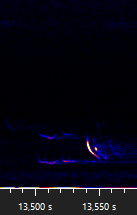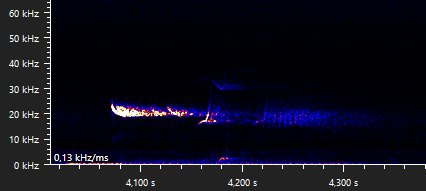Social calls of the Common noctule (Nyctalus noctula)
Recordings from 2024 and before
To listen to social calls of the common noctule, you can visit the files of the following lists on Xeno Canto:
- Type A social calls of different species of bats
- Type B (roosting) social calls of multiple species of bats
- Type C.d (high frequency FM) social calls of multiple (flying) species of bats
- Type C.d (male advertisement) social calls of Nyctalus spp.
- Type C social calls of the Common Noctule
- Type D social calls of the Common Noctule
These type A social calls were emitted from within the roost, located in a nearby tree. The bats were triggered to emit the sound by shaking a bunch of keys.

Not to be confused with an advertising male, producing type C social calls:

Date of recording: 2024-08-25 Recorded by: Kaia Pieters Audio file: 932486
Two of our fieldworkers found a roost of the common noctule in a tree, assumed to be a mating roost. One bat was clearly visible sitting inside the tree hole, while it was emitting calls. This bat is assumed to be the male. The calls are very similar to the recordings of Jon Russ of a male noctule calling from a tree (Russ, 2021). A few encounters with a close-approaching bats, assumed to be female, took place. A big variety of social calls were recorded.
Some social calls appear to fit into the type B category:






More low frequency notes are recorded, some that tends to be shaped like upside-down u's, some that seem to form a trill and some QCF's:











The bats weren't holding back emitting type D trills and type C calls:












And last but not least, some interesting hooked echolocation calls were prevalent aswell:


The following social calls (both type C and type D) are snippits of the complex songs that have been recorded with a stationairy bat logger in the area near a roost:






The moment our colleague Dennis heard very similar social calls on a different location, it was to no surprise that he found the location of the roost in a tree nearby in the evening of the next day. In the same recording, some particular type C social calls of the common pipistrelle are also present (not shown here).



These social calls were recorded near an active mating roost:










Social calls of the common noctule were encountered on multiple occasions during our surveys outside of mating season.

Date of recording: 2024-05-20 Recorded by: Paula Gerlag Audio file: 910947


Date of recording: 2024-05-22 Recorded by: Charlotte Serrarens Audio file: 910942
Timo saw four common noctules flying from west to east about 10 minutes after following recording.



Date of recording: 2024-06-07 Recorded by: Timo Boer Audio file: 911207




This recording contains calls from the same common noctules as the previous two recordings of Gijs. There are two trills of one individual common noctule present in the recording 'hidden' by a feeding buzz from the other common noctule:

Date of recording: 2024-06-08 Recorded by: Niels Jansen Audio file: 911512
Two common noctules were seen flying together from the North-East towards the South-West. They emitted these social calls in flight:



Date of recording: 2024-06-05 Recorded by: Marinus van der Meulen Audio file: 912136
This recording deviates from the others by being mainly echolocation. Type D social calls are emitted after short periods of regular echolocation calls. In the time span of 80 minutes, five common noctules were seen flying South.


Date of recording: 2024-06-14 Recorded by: Nils Reinerie Audio file: 913312
About an hour before the previous recording, Nils already recorded a variety of social calls of the common noctule:




Date of recording: 2024-06-14 Recorded by: Nils Reinerie Audio file: 913398
Some of the social calls in this recording are particulary low in frequency. To me, it feels like a new type of call is present that sounds like two 'stairs' of three steps. The first stairs goes from the first step at 8,5 - 9 kHz to two steps at 11 - 16 kHz (this sequence is emitted two times). The second stairs goes from a step at 16 kHz to a step at 17 kHz to a step at 17,5 - 18,5 kHz (this sequence is emitted three times). Three calls with an in frequency ascending ending are also present. Their start frequency are around 20 kHz and their end frequency are around 22,5+ kHz. I have seen these calls before, in the recording of Dennis on 2024-04-27 for example.





Date of recording: 2024-06-18 Recorded by: Tessa van der Eng Audio file: 914235







Date of recording: 2024-06-27 Recorded by: Lisa Vermaning Audio file: 917065
Two common noctules were seen flying in tandem when the next recording was taken:











This variety of social calls were recorded in an area where two common noctules were witnessed to forage very soon after sundown (at 22:06, while sundown was at 21:59). Due to their quick presence, a roost in the area would not be surprising. The surrounding habitat was ideal for common noctule roosts. I was surprised to see that the calls, that I previously described as two qCF type C social calls that ascend in frequency at the end, were connected to from a slow trill in the call between 4,140 s and 4,200 s (snippit on the right). It also shows that the first call below 20 kHz and the second call above 30 kHz definitely belong together in a motif (first snippit below). Another call shape around 20 kHz, that I previously would have describes as an ascending call, is visible in this recorded between 6,400 s and 6,700 s (second snippit below). These two calls start with an FM sweep to create a V-shape.




Date of recording: 2024-07-13 Recorded by: Sarah Mahie Audio file: 920702
High-frequency social calls of the common noctule. Echolocation calls of a Nathusius' pipistrelle and a common pipistrelle are also visible in the background.

Date of recording: 2024-08-02 Recorded by: Ricardo Woudsma Audio file: 924811
All recordings are licensed under the following Creative Commons Attribution-NonCommercial-NoDerivs 4.0 license and in courtesy of Sarah Mahie.
All sonograms are screenshots of the recordings imported in the ultrasound analysis software BatExplorer 2.2 (Elekon, Switzerland).
Bibliography:
- Jon Russ (2021). Bat Calls of Britain and Europe: a Guide to Species Identification. Pelagic Publishing.
- Neil Middleton, Andrew Froud and Keith French (2022). Social Calls of the Bats of Britain and Ireland (second edition). Pelagic Publishing.



Create Your Own Website With JouwWeb